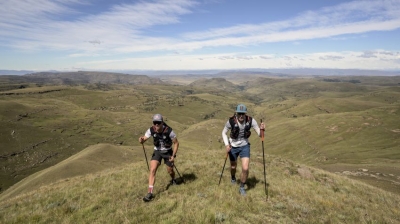
Video Ad Feedback
Ultra runner Ryan Sandes' must-haves for navigating Lesotho
02:21
– Source:
CNN
African Voices
16 videos
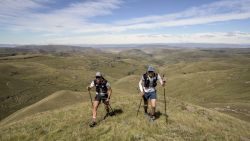
Video Ad Feedback
Ultra runner Ryan Sandes' must-haves for navigating Lesotho
02:21
Now playing
– Source:
CNN
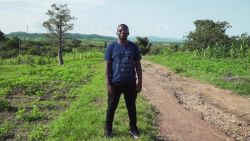
Video Ad Feedback
Meet the creatives elevating Africa's film industry
23:00
Now playing
– Source:
CNN
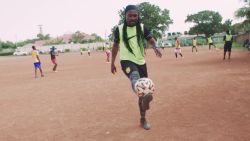
Video Ad Feedback
Former pro footballer scouts next generation of African players
02:52
Now playing
– Source:
CNN
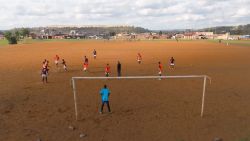
Video Ad Feedback
Legendary footballers move the sport forward in Africa
23:02
Now playing
– Source:
CNN

Video Ad Feedback
The 'Miracle Doctor' giving people their sight back
23:01
Now playing
– Source:
CNN
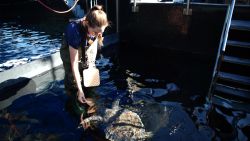
Video Ad Feedback
Saving southern Africa's sea turtles and penguins
03:46
Now playing
– Source:
CNN
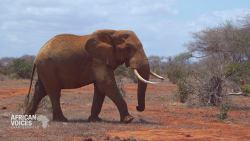
Video Ad Feedback
The conservations protecting Africa's vulnerable animals
23:01
Now playing
– Source:
CNN
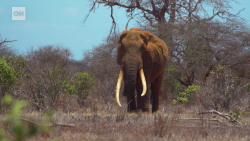
Video Ad Feedback
Protecting Kenya's 'Super Tusker' elephants
03:23
Now playing
– Source:
CNN
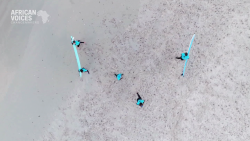
Video Ad Feedback
A surfer's love for the sport helps transform communities
03:11
Now playing
– Source:
CNN
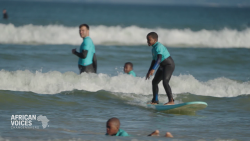
Video Ad Feedback
How water sports are making waves in Africa
23:00
Now playing
– Source:
CNN

Video Ad Feedback
Meet the Nigerian entrepreneur bringing 'The Headies' to America
03:24
Now playing
– Source:
CNN
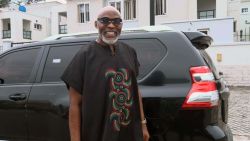
Video Ad Feedback
My Drive with Richard Mofe-Damijo
04:13
Now playing
– Source:
CNN
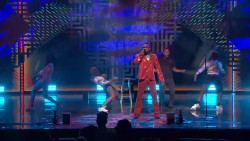
Video Ad Feedback
Moving Africa forward through music
23:02
Now playing
– Source:
CNN

Video Ad Feedback
This South African choreographer is making dance more accessible
03:35
Now playing
– Source:
CNN

Video Ad Feedback
Choreographer Izzy Odigie is spreading Afrobeat dance around the world
03:11
Now playing
– Source:
CNN

Video Ad Feedback
These African choreographers inspire through dance
23:02
Now playing
– Source:
CNN
See More Videos
CNN
—
There wasn’t a hint of exhaustion on Ryan Sandes’ face during a recent CNN interview with the decorated ultra-athlete in his Cape Town home. You’d never guess he had recently returned from an epic 16-day run along the mostly uncharted mountains of Lesotho’s borders – until he took off his shoes.
For runners, blisters and cracked feet are par for the course; they’re practically a source of pride for Sandes and his running partner Ryno Griesel, who together created and subsequently completed Navigate Lesotho on April 27. They covered 1,100 kilometers (684 miles) with over 33,000 meters of elevation gain in 16 days, 16 hours and 56 minutes – all under extreme weather conditions.
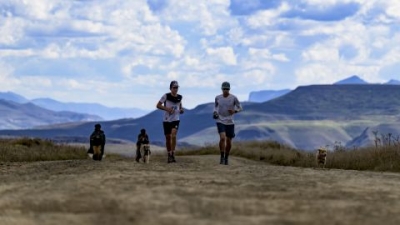
Ryan Sandes (left) and Ryno Griesel (right) during a leg of their Navigate Lesotho run.
Craig Kolesky / Red Bull Content Pool
“In some ways it was our toughest challenge, but because of what we’ve learned in the past, I think our maturity and just the bond we have, made it a lot easier,” Sandes told CNN.
The South African duo are no strangers to extreme adventures. Together, they hold the record for fastest known time (FKT) on one of the toughest routes in the world – the Great Himalaya Trail in Nepal, where they covered 1,504 kilometers (934.5 miles) in 25 says. They also hold the FKT on their home country’s renowned Drakensberg Grand Traverse, breaking the previous record by 18 hours.
Even during Covid-19 lockdowns in South Africa, Sandes managed to get in an unofficial 100-mile ultramarathon – around his house – which he finished in 26 hours.
“He had done about 140 kilometers (87 miles) and he was like, ‘I cannot go any further, this is the hardest thing I’ve ever done,’” Sandes’ wife Vanessa Haywood recounts of the one-man race.
But circumnavigating Africa’s “Mountain Kingdom” would prove to be even more grueling.
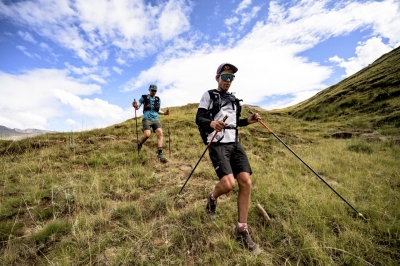
South African endurance athletes Ryan Sandes and Ryno Griesel are no strangers to running across challenging terrain. The duo recently ran the entire border of Lesotho (pictured) in 16 days. Look through the gallery to see more of the world’s most extreme foot races.
Craig Kolesky / Red Bull Content Pool
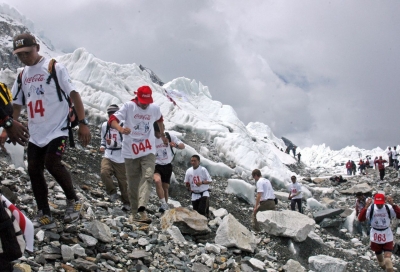
Everest: It’s hard to imagine climbing Mount Everest — let alone running it. But that’s what hundreds of marathon runners have been doing each year since 2003. Pictured: runners compete in the Everest Hillary Marathon across Everest’s Base Camp, in 2006.
Bikash Karki/AFP/Getty Images
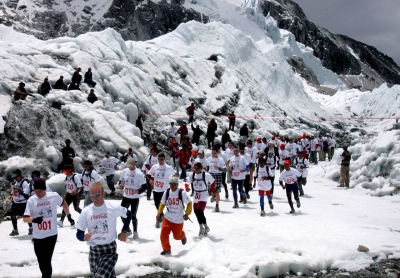
Everest: The world’s highest marathon, runners begin at Base Camp (elevation 5,364 meters) and end at in the Nepalese town of Namche Bazar.
Bikash Karki/AFP/Getty Images
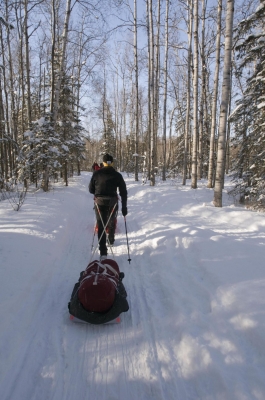
Iditarod Trail: Everest isn’t the only cold-weather trail. In Alaska, endurance runners complete in the 350-mile (563 kilometers) Iditarod Invitational Race, following the same path as the iconic sled dog race.
Dan Bailey/Design Pics/ZUMA Press
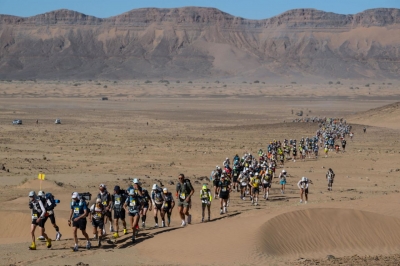
Morocco: From the snow to the sand, the Marathon des Sables in Morocco’s Sahara Desert is a grueling race against the heat. Here, runners take part in the third stage in March 2022.
Jean-Philippe Ksiazek/AFP/Getty Images
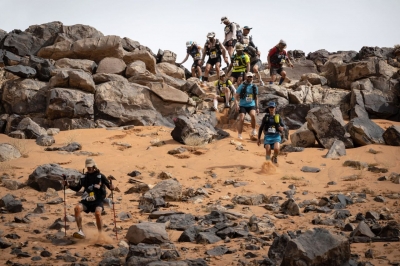
Morocco: Pictured: runners compete in stage four, which comprises of nearly 86 kilometers (53 miles) over two days. In total, the race covers 250 kilometers (186 miles) in one of the world’s harshest climates. The race is billed as the “toughest footrace on Earth.”
Jean-Philippe Ksiazek/AFP/Getty Images
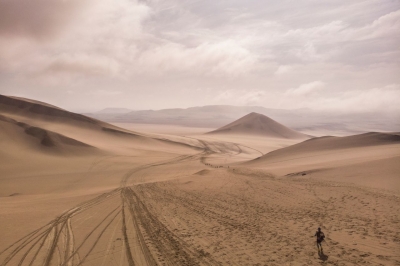
Peru: The Half Marathon des Sables race through the Ica Desert in Peru also pits athletes against extreme conditions. Despite being called a half marathon, the distance is actually up to 120 kilometers (75 miles), split into multiple stages across the desert landscape.
Martin Bureau/AFP/Getty Images
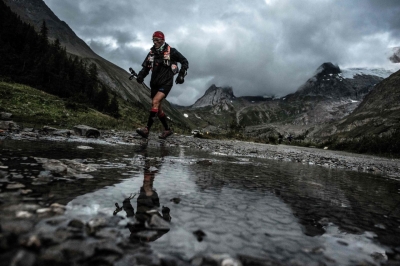
The Alps: The annual mountainous ultramarathon of the Ultra-Trail of Mont-Blanc covers 170 kilometers (106 miles) in the Alps across France, Italy and Switzerland. Runners, such as this competitor in the 2018 iteration, face a variety of challenging conditions from snow and wind to the darkness of night, all while making several passes through high altitude.
Jeff Pachold/AFP/Getty Images
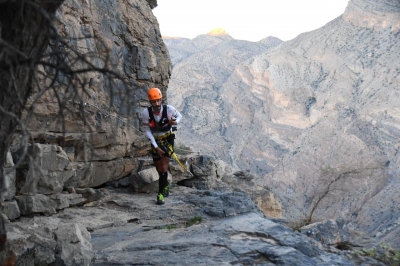
Oman: The Ultra-Trail of Mont-Blanc also has an Oman event, featuring “the majestic heights of Oman’s mountainous interior.” Swiss runner Diego Pazos (pictured) finished second in the 137-kilometer (85 miles) marathon’s inaugural event in 2018.
Giuseppe Cacace/AFP/Getty Images
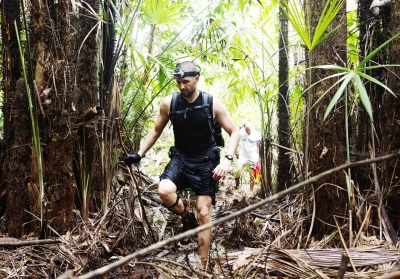
The Amazon: Dense jungle is not exactly primed for a foot race, but that hasn’t stopped runners from traversing the Amazon in Brazil’s Jungle Marathon. Here, an endurance athlete competes in 2013, when the race covered 245 kilometers (152 miles) in seven days.
London News Pictures/Shutterstock
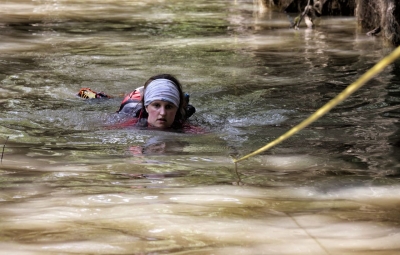
The Amazon: The terrain of the jungle also calls for the occasional water crossing. Pictured: Great Britain’s Amy Gasson swims across a river during the ultramarathon in 2014.
Alexander Beer/Lnp/Shutterstock
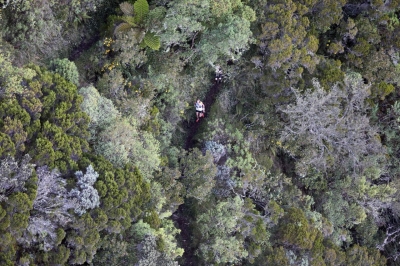
La Reunion island: More dense forest awaits runners (such as this competitor in 2019) in the Grand Raid de la Reunion ultramarathon race, on the island of La Reunion in the Indian Ocean.
Richard Bouhet/AFP/Getty Images
These are some of the most extreme foot races on Earth
Prev
Next
Lesotho on foot
“Lesotho was definitely the most challenging in terms of conditions, although you don’t think about it that way, because it’s so close to home,” Griesel said, adding that it’s a five-hour drive from Johannesburg.
The expedition required two years of planning, or what Griesel likens to “building a puzzle.” The pre-production involved plotting unmapped territory, getting sponsors on board, building relationships with locals and scoping out areas of the route they’d later run.
“People often say the hardest part is getting to the starting point and honestly (it) is, and then the rest of the hardest part starts,” he said.
Related story: This man biked from London to Lagos
They ran about a marathon and a half each day, trudging through extremely cold, snowy, windy and muddy conditions according to Sandes. In total, Sandes and Griesel crossed 187 rivers.
Temperatures ranged from -5 degrees to 30 degrees Celsius throughout the trip.
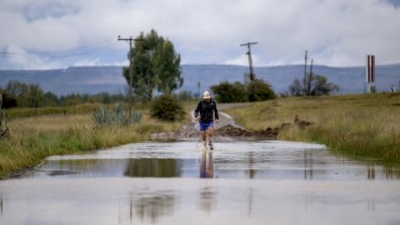
Sandes fording a river during the 16-day run around Lesotho. He says he went through a pair of socks every day.
Craig Kolesky / Red Bull Content Pool
Some nights they slept, sometimes they didn’t, depending on conditions and keeping on pace with their targeted 17-day finish.
The running duo had to deviate from Plan A quite a few times, and Sandes said they backtracked a few mountains and rivers and took alternate routes due to poor conditions.
A mental marathon
Navigating Lesotho proved to be mentally tough as well, but the pair decided early on that giving up was not an option.
“When you’ve been shivering for two to three days, you can’t even think clearly because you haven’t slept, you’re super hungry, ran out of food two days ago … there’s always 1,000 good reasons to quit,” Griesel said, “but once you take that off the table, then you’re forced to keep moving towards the goal.”
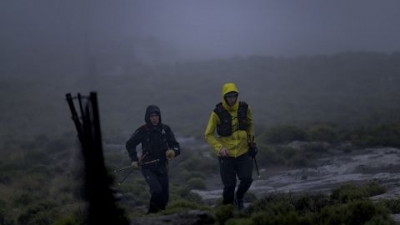
Griesel and Sandes making a big push up one of Lesotho’s many mountains during a particularly rainy day.
Craig Kolesky / Red Bull Content Pool
They carried an impressive load in their packs: clothes, food, water, extra socks, GPS trackers, water purification straws, headlamps, hiking poles, sunscreen and more.
And for fuel? Each runner carried a mixture of whole foods and carb-heavy electrolyte mixes, plus one dehydrated meal per day. They estimate they burned 120,000 calories throughout the journey.
Griesel said his favorites foods that got him through Lesotho were hot cross buns and chocolate. “I’ve always been really bad with diet if you had to look at it from a traditional point of view, but I do believe that the best food[s] on these long projects are what you’re looking forward to eating,” he added.
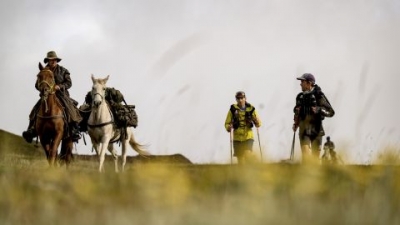
A crew on horseback support Sandes and Griesel during a leg of their Lesotho circumnavigation run.
Craig Kolesky / Red Bull Content Pool
They weren’t completely alone in their expedition; a support crew on horseback, motorbikes and four-by-fours helped resupply their basic needs and give them cooked food at various pre-planned locations.
Two peas in a pod
Sandes (40) and Griesel (42) met in 2012 at the ultra-trail race Salomon SkyRun South Africa, where Sandes placed first and Griesel third. Two years later, they would run the Drakensberg Grand Traverse together – and break the FKT record.
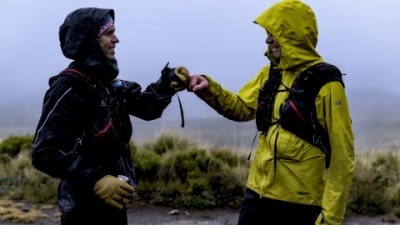
Sandes and Griesel celebrate completing a difficult stretch of their Lesotho journey.
Craig Kolesky / Red Bull Content Pool
“That was definitely where our friendship started,” Sandes said, adding “Ryno and I are very different people, but I think we really complement each other.”
Sandes joked that Griesel’s race gear will be labeled and in order, while his own is in a disorganized pile.
“Even if I look at what we bring to the table, I come from more of a running background and competing on the international circuit, whereas Ryno is more into adventure racing and his mountain skills and navigating [are] next level,” he said.
Related story: Kenya dominates the 2022 Boston Marathon
Sandes is the physical powerhouse and Griesel is the nimble navigator.
“It’s all good and well to go fast – it’s ideal to go fast in the right direction and I think that’s where we really fit together,” Griesel said.
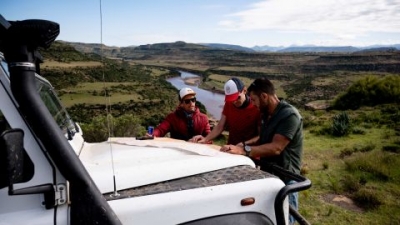
The ultra runners said it took about two years to map out their Lesotho route.
Craig Kolesky / Red Bull Content Pool
The humble runners balance each other out in more ways than their skillsets. Griesel said Sandes is good at keeping morale going by celebrating the “mini milestones,” which helped him push through during their Lesotho run.
“We’ll get to the top of [a summit] and I’ll be like, ‘I still need 10 days to finish this,’ and he would be reminding me of where we’ve come from,” Griesel said.
Staying close to home
While these two will likely continue going for FKTs, Sandes said the pandemic has created space for him to slow down and appreciate what his home continent has to offer.
Related story: Meet three Black climbers taking representation to new heights on summits across Africa and around the world
“Throughout my career, I’ve been lucky enough to run on all seven continents and experience a lot of the world, but I feel like I haven’t experienced enough of Africa,” he said. “And I think being forced to do more locally has made me really grow to love home even more.”
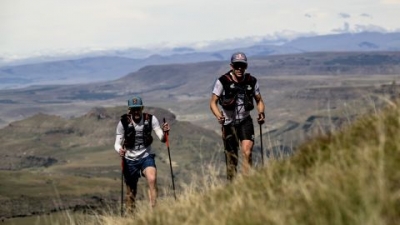
Sandes and Griesel look forward to spending more time on their home continent. Here they’re pictured trekking up a steep incline during their Navigate Lesotho run.
Craig Kolesky / Red Bull Content Pool
The pair are also focused on bringing up the next generation of South African runners through programs like LIV2Run which aims to help uplift people from disadvantaged communities.
“In life we all kind of need that connection to the outdoors,” Sandes said. “I think we’re so connected to technology, [we need to] break that and to feel free and natural and whole again.”
